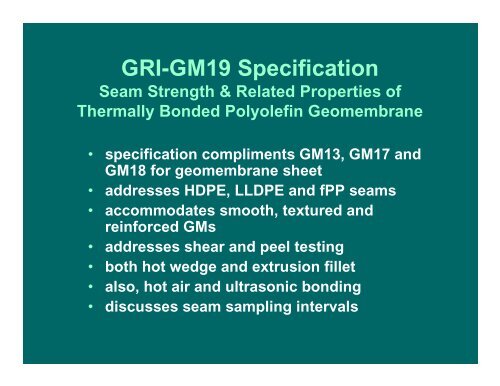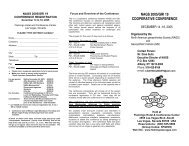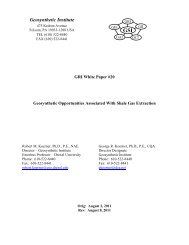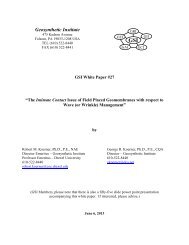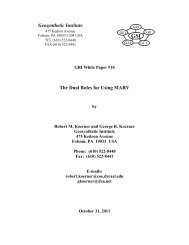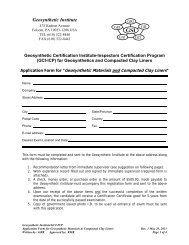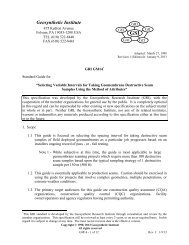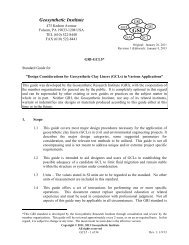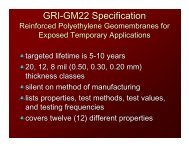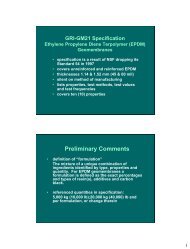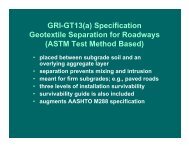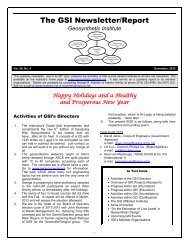GRI-GM19 Specification - The Geosynthetic Institute
GRI-GM19 Specification - The Geosynthetic Institute
GRI-GM19 Specification - The Geosynthetic Institute
You also want an ePaper? Increase the reach of your titles
YUMPU automatically turns print PDFs into web optimized ePapers that Google loves.
<strong>GRI</strong>-<strong>GM19</strong> <strong>Specification</strong>Seam Strength & Related Properties of<strong>The</strong>rmally Bonded Polyolefin Geomembrane• specification compliments GM13, GM17 andGM18 for geomembrane sheet• addresses HDPE, LLDPE and fPP seams• accommodates smooth, textured andreinforced GMs• addresses shear and peel testing• both hot wedge and extrusion fillet• also, hot air and ultrasonic bonding• discusses seam sampling intervals
Preliminary Comments• utilizes ASTM D6392 (both ASTMD4437 and D4545 are depreciated)• includes shear and peel strengths• includes shear elongation andpeel separation• gives unacceptable locus-of-breakpatterns (codes)
Seam Cross Section
Field Sampling of GM Seams• no formalized procedure or standard• EPA technical guidance manual is availableEPA 600/R-93/182 (September, 1993) byKoerner & Daniel… its dated!• typical standard of 1 sample per 150 m (500ft.) is suggested• interval is based on “old” technology (solventand extrusion flat methods)• interval should be flexible depending on thequality of installation
Method of Attributes• follows <strong>GRI</strong> GM14 Standard• rewards “good” installers (with longersampling intervals)• penalizes “poor” installers (with closersampling intervals)• needs original and ongoing statistics• alternative method uses control charts;but method is not standardized
ASTM D6392• test specimens are 25 mm (1.0 in.) wide• specimen length 150 mm (6.0 in.)• seam is located centrally andperpendicular to length• must be cut using sharp dies• no knives or cutting tables permitted• two types of tests: shear and peel with5 specimens of each type
ShearTestPeel Test
Specimen Sampling Patternper ASTM D6392
Regarding Shear Testing• 4/5 must spec table value• outlier 80% spec table value• table values are percentages ofsheet tensile strengths• HDPE (~ 95%); LLDPE (varies);fPP (~ 75%)• shear test follows
Shear TestPhoto 1
Shear TestPhoto 2
Shear TestPhoto 3
Shear TestPhoto 4
Shear TestPhoto 5
Regarding Shear ElongationELLo(100)E = elongation ( 50% for all seams)L = elongation at breakL o = gage length (typ. 25 mm)
Some Additional Details AboutShear Testing• speed 50 mm/min (2 in./min) for HDPE500 mm/min (20 in./min) for more flexible GMs• both tracks of DTHW seams need to be testedindividually by cutting through the air channel• grip separation 50 mm (2 in.) plus seam width• gauge length is 25 mm (1 in.)• test is complete for HDPE at 50% elongation• more flexible GMs need to be tested to failure
Regarding Peel Testing• 4/5 must spec table value• outlier 80% spec table value• tables values are percentages ofsheet tensile strengths• HDPE (~ 62%); LLDPE (~ 76%);fPP (~ 80%)• peel test follows
Peel TestPhoto 1
Peel TestPhoto 2
Peel TestPhoto 3
Peel TestPhoto 4
Peel TestPhoto 5
Regarding Peel Separation• also called peel “incursion”whereS AAoS = separation ( 25% for all seams)A = average area of separationA o = original bonded area• A and A o are visual approximations• tack weld and squeeze-out are not included100
Some Additional Details• speed 50 mm/min (2 in./min) for HDPE500 mm/min (20 in./min) for moreflexible GMs• both DTHW seams are tested fromoutside in toward the air channel• grip separation equals 50 mm (2 in.)• estimate of separation is reported tothe nearest 25%• if grip separation is reduced it must bereported accordingly
Locus-of-Break Patterns (Codes)• following are unacceptable patternsHot Wedge AD & AD-Brk > 25%Ext. Fillet AD1, AD2 & AD-WLD(unless strength is achieved)• SIP is acceptable; it is sheet related
Unacceptable Hot Wedge Weld Breaks(>25% incursion)
Unacceptable Extrusion Fillet Welds(unless strength is achieved)
Regarding SIP Failures• separation-in-plane (SIP) isdisconcerting• generally occurs in peel testing• can “travel” within sheet aconsiderable distance• many opinions as to cause• its sheet related; hence approvedas far as seam spec is concerned
SIP in Dual Track Hot Wedge SeamSIP in Extrusion Fillet Seam
Concluding Comments• spec addresses HDPE, LLDPE and fPPgeomembrane seams• accommodates smooth, textured andreinforced geomembranes• silent on sheet manufacture method• addresses hot wedge (single and dualtrack) and extrusion fillet seams• if testing conducted in the field, shearelongation and peel separation can beeliminated and reported accordingly
<strong>The</strong> Basic Tables FollowHDPE – smooth and texturedLLDPE – smooth and texturedfPP – nonreinforced and reinforcedNote: <strong>The</strong> most recent version of this specification (textand tables) is available on the GSI Web Site.


